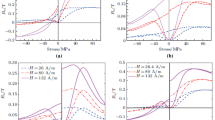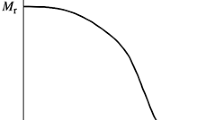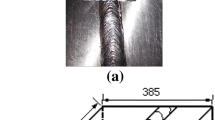Abstract
A technique based on the metal magnetic memory (MMM) is developed to evaluate the contact damage of ferromagnetic materials under nonferromagnetic and ferromagnetic indenters by measuring the magnetic flux leakage (MFL) signals. Great difference between the MFL signals for the ferromagnetic indenter and non-ferromagnetic indenter is experimentally observed. The normal signal shows a dip in the contact region for the ferromagnetic indenter but an increase for the non-ferromagnetic indenter; the tangential signal experiences a peak-peak change through zero in the contact region for the ferromagnetic indenter but a peak for the non-ferromagnetic indenter. Furthermore, the amplitude of MFL signals for the ferromagnetic indenter is considerably larger than that for the non-ferromagnetic indenter. The mechanism of the signal variation is analyzed by considering the magnetic-stress coupling effect. Criteria of the early contact damage are developed based on the variations of the MFL signals and their gradients; and the evaluation parameters are extracted.





















Similar content being viewed by others
References
Doubov AA (1998) Screening of weld quality using the metal magnetic memory. Weld World 41:196–199
Wang ZD, Gu Y, Wang YS (2012) A review of three magnetic NDT technologies. J Magn Magn Mater 324(4):382–388
Doubov AA, Vstovsky GV (2000) Physical base of the method of metal magnetic memory, Moscow
Doubov AA (2001) Diagnostics of equipment and constructions strength with usage of magnetic memory. Inspection Diagnostics 6:19–29
Roskosz M (2011) Metal magnetic memory testing of welded joints of ferritic and austenitic steels. NDT&E Int 44:305–310
Yao K, Deng B, Wang ZD (2012) Numerical studies to signal characteristics with the metal magnetic memory-effect in plastically deformed samples. NDT & E Int 47:7–17
Ren SK, Song K, Ren JL (2009) Influence of enviromental magnetic field on stress magnetism effect for 20 steel ferromatnetic specimen. Insight 51(2):672–675
Dong LH, Xu BS, Dong SY, Song L, Chen JZ, Wang D (2009) Stress dependence of the spontaneous stray field signals of ferromagnetic steel. NDT & E Int 42:323–327
Jian XL, Jian XC, Deng GY (2009) Experiment on relationship between the magnetic gradient of low-carbon steel and its stress. J Magn Magn Mater 321:3600–3606
Shi CL, Dong SY, Xu BS, He P (2010) Metal magnetic memory effect caused by static tension load in a case-hardened steel. J Magn Magn Mater 322:413–416
Guo PJ, Chen XD, Guan WH, Chen HY, Jiang H (2011) Effect of tensile stress on the variation of magnetic field of low-alloy steel. J Magn Magn Mater 323:2474–2477
Roskosz M, Bieniek M (2012) Evaluation of residual stress in ferromagnetic steels based on residual magnetic field measurements. NDT & E Int 45:55–62
Yao K, Wang ZD, Deng B, Shen K (2012) Experimental research on metal magnetic memory technique. Exp Mech 52(3):305–314
Leng JC, Xu MQ, Xu MX, Zhang JZ (2009) Magnetic field variation induced by cyclic bending stress. NDT & E Int 42:410–414
Shi CL, Dong SY, Xu BS, He P (2010) Stress concentration degree affects spontaneous magnetic signals of ferromagnetic steel under dynamic tension load. NDT & E Int 43(1):8–12
Dong LH, Xu BS, Dong SY, Chen QZ, Wang D (2008) Monitoring fatigue crack propagation of ferromagnetic materials with spontaneous abnormal magnetic signals. Int J Fatigue 30:1599–1605
Li CC, Dong LH, Wang HD, Li GL, Xu BS (2016) Metal magnetic memory technique used to predict the fatigue crack propagation behavior of 0.45%C steel. J Magn Magn Mater 405:150–157
A.A. Doubov. Principal features of metal magnetic memory method and inspection tools as compared to known magnetic NDT methods. In: Proceedings of the 16th annual world conference on non-destructive testing. Montreal, Canada, 27(9): 1034–1037 (2006)
Jiles DC (1998) Theory of the magnetomechanical effect. J Phys D Appl Phys 28:1537–1546
Wang ZD, Deng B, Yao K (2011) Physical model of plastic deformation on magnetization in ferromagnetic materials. J Phys D Appl Phys 109:083928
Shi PP, Zheng XJ (2016) Magnetic charge model for 3D MMM signals. Nondestruct Test Eva 31(1):45–60
Yao K, Wang ZD, Wang YS (2014) Three-dimensional finite element analysis of residual magnetic field for ferromagnets under early damage. J Magn Magn Mater 254:112–118
Acknowledgements
This work was financially supported by the Fundamental Research Funds for the Central Universities (2016RC023) and National Natural Science Foundation of China (no. 11402018).
Author information
Authors and Affiliations
Corresponding authors
Additional information
Publisher’s Note
Springer Nature remains neutral with regard to jurisdictional claims in published maps and institutional affiliations.
Rights and permissions
About this article
Cite this article
Yao, K., Wu, L. & Wang, Y. Nondestructive Evaluation of Contact Damage of Ferromagnetic Materials Based on Metal Magnetic Memory Method. Exp Tech 43, 273–285 (2019). https://doi.org/10.1007/s40799-019-00311-5
Received:
Accepted:
Published:
Issue Date:
DOI: https://doi.org/10.1007/s40799-019-00311-5




